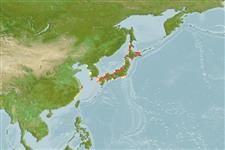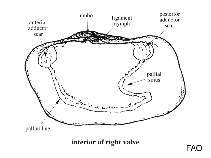Panopea japonica Adams, 1850
| Native range | All suitable habitat | Point map | Year 2050 |

|
| This map was computer-generated and has not yet been reviewed. |
| Panopea japonica AquaMaps Data sources: GBIF OBIS |
Google image | No image available for this species;
drawing shows typical species in Hiatellidae.
Classification / Names Common names | Synonyms | CoL | ITIS | WoRMS
Bivalvia | Adapedonta | Hiatellidae
Environment: milieu / climate zone / depth range / distribution range Ecology
Benthic. Subtropical
Distribution Countries | FAO areas | Ecosystems | Occurrences | Introductions
Northwest Pacific: Korea Republic, China and Japan.
Length at first maturity / Size / Weight / Age
Maturity: Lm ? range ? - ? cm Max length : 16.0 cm SHL male/unsexed; (Ref. 128019); max. published weight: 800.00 g (Ref. 128019)
Life cycle and mating behavior Maturity | Reproduction | Spawning | Eggs | Fecundity | Larvae
Main reference
References | Coordinator | Collaborators
Beu, A. and A. Kitamura 1998 Exposed coasts vs. sheltered bays: contrast between New Zealand and Japan in the molluscan record of temperature change in Plio-Pleistocene cyclothems. Sedimentary Geology 122:129-149. (Ref. 77625)
IUCN Red List Status
(Ref. 130435: Version 2025-1)
CITES status (Ref. 108899)
CMS (Ref. 116361)
Threat to humans
Human uses
Fisheries: commercial
| FishSource |
Tools
More information
Diet composition
Food consumption
Predators
Max. ages / sizes
Length-weight rel.
Length-length rel.
Length-frequencies
Mass conversion
Abundance
Internet sources
BHL | BOLD Systems | CISTI | DiscoverLife | FAO(Publication : search) | Fishipedia | GenBank (genome, nucleotide) | GloBI | Gomexsi | Google Books | Google Scholar | Google | PubMed | Tree of Life | Wikipedia (Go, Search) | Zoological Record



